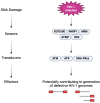Chronic HIV Transcription, Translation, and Persistent Inflammation
- PMID: 38793632
- PMCID: PMC11125830
- DOI: 10.3390/v16050751
Chronic HIV Transcription, Translation, and Persistent Inflammation
Abstract
People with HIV exhibit persistent inflammation that correlates with HIV-associated comorbidities including accelerated aging, increased risk of cardiovascular disease, and neuroinflammation. Mechanisms that perpetuate chronic inflammation in people with HIV undergoing antiretroviral treatments are poorly understood. One hypothesis is that the persistent low-level expression of HIV proviruses, including RNAs generated from defective proviral genomes, drives the immune dysfunction that is responsible for chronic HIV pathogenesis. We explore factors during HIV infection that contribute to the generation of a pool of defective proviruses as well as how HIV-1 mRNA and proteins alter immune function in people living with HIV.
Keywords: HIV; defective proviruses; inflammation; persistence; transcription.
Conflict of interest statement
The authors declare no conflicts of interest.
Figures





Similar articles
-
Intragenic proviral elements support transcription of defective HIV-1 proviruses.PLoS Pathog. 2021 Dec 28;17(12):e1009982. doi: 10.1371/journal.ppat.1009982. eCollection 2021 Dec. PLoS Pathog. 2021. PMID: 34962974 Free PMC article.
-
Defective HIV-1 genomes and their potential impact on HIV pathogenesis.Retrovirology. 2022 Jun 28;19(1):13. doi: 10.1186/s12977-022-00601-8. Retrovirology. 2022. PMID: 35764966 Free PMC article. Review.
-
Long-term persistence of transcriptionally active 'defective' HIV-1 proviruses: implications for persistent immune activation during antiretroviral therapy.AIDS. 2023 Nov 15;37(14):2119-2130. doi: 10.1097/QAD.0000000000003667. Epub 2023 Aug 22. AIDS. 2023. PMID: 37555786 Free PMC article.
-
Intact Proviral DNA Analysis of the Brain Viral Reservoir and Relationship to Neuroinflammation in People with HIV on Suppressive Antiretroviral Therapy.Viruses. 2023 Apr 20;15(4):1009. doi: 10.3390/v15041009. Viruses. 2023. PMID: 37112989 Free PMC article.
-
Single-molecule techniques to quantify and genetically characterise persistent HIV.Retrovirology. 2018 Jan 9;15(1):3. doi: 10.1186/s12977-017-0386-x. Retrovirology. 2018. PMID: 29316955 Free PMC article. Review.
References
-
- Angel C.J.L., Pham E.A., Du H., Vallania F., Fram B.J., Perez K., Nguyen T., Rosenberg-Hasson Y., Ahmed A., Dekker C.L., et al. Signatures of immune dysfunction in HIV and HCV infection share features with chronic inflammation in aging and persist after viral reduction or elimination. Proc. Natl. Acad. Sci. USA. 2021;118:e2022928118. doi: 10.1073/pnas.2022928118. - DOI - PMC - PubMed
Publication types
MeSH terms
Substances
Grants and funding
LinkOut - more resources
Full Text Sources
Medical

